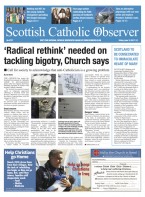March 24 | ![]() 0 COMMENTS
0 COMMENTS ![]() print
print

The joys of a Catholic childhood in Dundee
JIM SPENCE, the Dundee-based broadcaster and writer, looks back fondly on his days of football, berry-picking and slow dances in a city where a quarter of the population was Catholic
As a boy growing up in Dundee I had no sense that in Scotland it might be unusual to be a Catholic. In the world capital of the jute industry it certainly wasn’t. In Dundee we made up nearly a quarter of the population.
At the turn of the 20th century, around 25 per cent of Dundee’s population was Irish-born or of Irish extraction, with many of the women having come to the city bringing their skills from the textile industry in places like Donegal, Derry, Monaghan, Sligo and Tyrone.
I was born in my granny’s house in the Beechwood area of Dundee, opposite the home of the city’s then premier junior football team, Lochee Harp, in March 1955 on my mother’s 34th birthday. Just a kick of a football along the road was the 282-foot towering edifice of Cox’s stack, the famous jute mill chimneystack which loomed over Lochee, or little Tipperary as it was known, because of the huge numbers of Irish workers who had settled there.
Cox’s stack was once memorably described by a Glasgow woman who had walked to the city for work in the Dundee jute mills as her ‘statue of liberty,’ liberating her and others from hunger and unemployment back in their native city. The sweet smell of jute always hung in the air in Dundee, and on the buses and streets I can vividly recall the fibres covering the overalls of the men and women after a day’s work in the mills, which at their height employed 50,000 Dundonians.
I was a very late addition to the family. My brother Robert and sister May were 13 years senior, and my sister Maureen was ten years older.
My father, who had been in the RAF at nearby Leuchars, claimed that I was the second immaculate conception and promptly had me Baptised in what to me is Dundee’s most imposing Catholic church, Our Lady of Victories, St Mary’s Forebank, in the Hilltown.
When I was three years old the family moved to the Kirkton housing scheme where I lived until I was 16, firstly attending St Columba’s Primary School, and then eventually passing my 11-plus exam to qualify for Lawside RC Academy, one of the city’s three Catholic secondary schools.
I can still recall the surge of pride at being handed my first primary school football strip, the blue and yellow box pattern burned into my mind even yet.
I can also recall clearly the crushing disappointment of being dropped for the Rock Cup final, the competition for the city’s Catholic primaries, which we lost to St Pius. I wept tears the size of snowballs all the way home at one of life’s injustices.
I can also vividly recall almost choking at my First Communion, and Mr Kelly, our deputy headmaster, strongly imploring me, ‘Don’t touch the Host Spence’ as I gagged on the foreign texture. Confirmation day too was memorable as the class marched the quarter of a mile from school to the chapel, me proudly togged out in my newly acquired jacket and short trousers, taken ‘on tick’ from McGill’s department store, which had clothed and furnished generations in the city.
I was never conscious of any differences between myself and my non-Catholic mates, other than on St Patrick’s Day, when after Mass every year we set out to ‘take’ the ‘Hillocks.’
The Hillocks was a substantial mound of earth around 60 feet high shaped like the top of an extinct volcano, opposite St Columba’s chapel. It was defended keenly every March 17 by the boys and girls of Gillburn and West March primaries, who were, that day apart, our best pals. Primary school days were filled with football at playtimes and in the streets after school.
In the long seven-week school holidays we observed the Dundee tradition of going to the berries at the nearby Bentley’s berry fields.
The raspberries were hard graft, with hands cut to ribbon with the thorns, but the strawberries or ‘strassers’ as we called them, were truly backbreaking work and avoided wherever possible.
There was as much hilarity as serious picking went on, but there were many families who sorely needed the money and they were in the Dundee parlance called ‘nabblers.’
In other words they could pick berries at machine gun speed. The sight of buses full of berry pickers leaving early morning from the housing schemes for the various farms around the city will be lodged in the memory of nearly all Dundonians of my age.
The methods of ensuring that as much weight as possible went into the luggys (pails tied around the waist which we filled with berries), to ensure the best possible cash return for our labours, are best left unspoken in polite company.
The move up to secondary school to Lawside Academy brought me a wider circle of friends and broadened my horizons in the wider world.
The school attracted Catholic pupils from all over Dundee, as well as many from Arbroath, Blairgowrie, Forfar and Perth.
A regular feature of my youth, from around the age of ten, was Saturday morning trips into town for my superhero comics, Green Lantern and Superman being my favourites.
The arcade lay underneath the city’s impressive Caird Hall, which then had a 3,300 capacity and attracted top acts like The Beatles, The Rolling Stones and The Who.
The Caird Hall stood like a sentinel overlooking the city square, which was a favourite haunt to see in the bells at New Year in later teenage years.
It was also an al fresco venue for a variety of soap box orators of different political or religious hues, who would argue the toss with the barrackers in the crowds who gathered to listen to them.
It was also a source of great fun for boys with mischief in mind and who were quick with their tongues and on their feet, for the inevitable chase which followed the volley of cheek delivered to those pontificating from their boxes.
Dundee was a big dance hall and picture hall city. I was too young for the dance halls which were regular haunts for my brother and sisters, but in a city with a population of more than 180,000 with a cinema for every 6,000 folk, I did have a vast choice, and was a regular at the ABC, the Gaumont, the Odeon, the Plaza and the Victoria.
Occasionally there was a visit to the magnificent art deco Green’s Playhouse, which seated 4,123 patrons, only 100 less than the capacity of the similarly named cinema in Glasgow, which was then reputedly the biggest in Europe.
There was also the Tivoli in Dundee’s Hilltown, which showed foreign (ahem) cinematic masterpieces. I was too young for those and would have been skinned alive if my folks had even heard a whisper of me trying to blag my way in to the ‘Tiv’ as it was known.
Journeys into the city centre until around the age of ten were always an adventure and if I was with my mum there was usually a treat at one of the swanky restaurants and tearooms at one of the big department stores: Draffens, DM Brown’s or Caird’s.
My move to secondary school at Lawside Academy brought me a wider circle of pals and more regular outings to other areas of Dundee like Douglas, Fintry, Menzieshill, and Dryburgh, which could be fraught with danger at that testosterone-laden age.
I was often glad to have been blessed with being quick on my toes as some of the local natives chased me after a party in a strange part of town.
I had dallied with an occasional paper round but by the time I was in fifth year I was a working as a milk boy, rising at five am Monday to Saturday and performing daredevil leaps from a moving lorry with three pints in each hand, a ritual which would surely be in breach of health and safety laws in today’s world.
It also played havoc with my school work. By that age my excursions with my mates also took on a more adult hue, with Tuesday night trips to the Tufty club at the JM Ballroom in the city centre. The JM featured two live bands, and I have fond memories of doing the circuit of the dance floor, while scouting for a potential partner for a ‘moonie,’ the slow dance which was the Dundee precursor to hooking up with a steady girlfriend.
Sunday mornings even into my mid-teens were reserved for chapel which was always to my recollection pretty full for the two Masses at St Columba’s.
Then before I knew where I was, the big bad world had suddenly intruded and it was time to say goodbye to school and hello to the grown up world of work. That’s when I sadly discovered that the old saying, ‘school days are the happiest days of your life,’ was indeed the truth.











